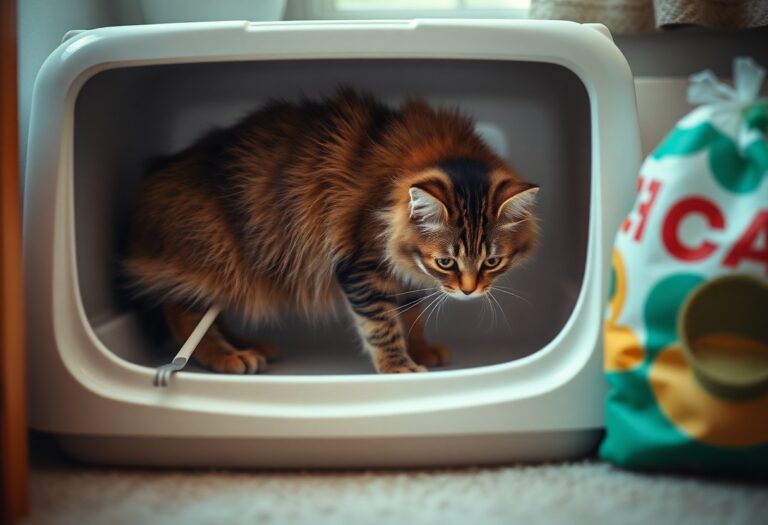Over time, you may find yourself facing various cat behavioral problems that can impact your cat’s well-being and your enjoyment as a pet owner. Understanding the root causes of issues like aggression, litter box refusal, and excessive meowing is crucial for fostering a harmonious environment. In this blog post, we’ll explore practical steps to quickly address these common challenges and enhance your relationship with your feline friend, ensuring a happier life for both of you.
Unpacking Feline Frustrations: Common Behavioral Issues
The Mystery of Litter Box Problems
Litter box issues can be extremely frustrating and may lead to anxiety in both you and your cat. If your feline friend is consistently missing the box or refusing to use it altogether, the reasons could range from stress to health-related concerns. Sometimes, it’s as simple as an unclean box—cats are notoriously finicky about cleanliness. You’ll want to ensure that you’re cleaning the litter box at least once a day and replacing the litter regularly. Also, consider the type of litter; cats often have preferences, and what works for one may not be suitable for another.
Health issues such as urinary tract infections or arthritis can also affect your cat’s litter box habits. If you notice sudden changes, an abnormal amount of straining, or blood in the urine, consulting your veterinarian promptly can rule out serious health problems. Implementing additional boxes—one for each cat in your household plus one extra—can also alleviate territorial disputes, encouraging proper use.
The Claws of Aggression: Understanding Cat-to-Cat Conflict
Cat-to-cat aggression is a common dilemma, especially in multi-cat households. Often, this behavior stems from territorial disputes or a simple personality clash. You might notice your cats hissing, swatting, or engaging in prolonged standoffs. One reason for this could be the presence of established furniture or resting spots that create an imbalance, leading each cat to compete for dominance. Additionally, introducing new cats or changes in the environment can intensify these feelings.
Gradual introductions are imperative when adding a new cat to your home. You can minimize territorial disputes by allowing cats to explore shared spaces at their own pace. Utilizing cat trees, scratching posts, or designated safe zones can also help create individual territories within your home, decreasing confrontations. Watch for warning signs of aggression, such as dilated pupils or excessively twitching tails, as your proactive measures can prevent future conflicts.
The Science of Stress: Environmental Factors Affecting Behavior
Understanding the root causes of stress in your cat is imperative for addressing their behavioral issues effectively. Numerous environmental factors contribute to an increase in feline anxiety, which can manifest as aggression, withdrawal, or other challenging behaviors. Elements such as changes in routine, new household members, or even the introduction of new pets can significantly impact your cat’s well-being. Additionally, the physical surroundings—including unpredictable noises, clutter, and a lack of safe spaces—can exacerbate their stress levels. Identifying and mitigating these stressors enables you to create a more harmonious living environment for your feline companion.
While physical space and environmental factors are significant, the psychological effects of stress also play a pivotal role in your cat’s behavior. Cats are incredibly sensitive to changes in their surroundings, and even minor shifts can lead to considerable unease. For example, a loud vacuum cleaner or a high-traffic area can make your cat feel cornered and anxious. Ensuring your home maintains a sense of calm—where your cat has areas to retreat and feel secure—is fundamental to their overall mental health. Any adjustments you can make to minimize stressors will not only improve your cat’s behavior but also enhance their quality of life.
Noise and Chaos: The Impact of Household Dynamics
High levels of noise and chaos in your home can significantly affect your cat’s sense of safety and comfort. These disturbances might come from children playing, bustling household activities, or constant loud sounds such as music or television. Cats thrive in quiet, predictable environments; thus, a noisy home can lead to increased anxiety and behavioral problems like excessive meowing, hiding, or unexpected aggression. Establishing specific quiet times during the day can help your cat feel more secure, allowing them to recharge.
Creating a peaceful environment requires awareness of these auditory stressors. You can incorporate white noise machines to muffle jarring sounds or aim to limit loud activities during the times when your cat is feeling particularly restless. Providing your cat with a designated quiet area where they can escape the commotion is also a beneficial strategy. This space needs to be comfortable, cozy, and equipped with their favorite toys and bedding, allowing your cat to retreat when needed.
Territorial Tensions: How to Mitigate Spatial Issues
Territorial disputes between household pets can lead to heightened stress and anxiety, often resulting in aggressive behaviors or avoidance tactics. Cats are inherently territorial creatures, and introducing a new cat or even moving furniture can disrupt their sense of ownership over their environment. To reduce territorial tensions, consider gradually introducing new pets, allowing for supervised interactions, and creating multiple resource areas (such as food, litter boxes, and resting spots) throughout your home. This approach ensures that each cat can maintain their space while minimizing conflicts.
Another effective strategy is ensuring vertical spaces, such as cat trees or shelves, which provide your cats with elevated perches to observe their surroundings from a safe distance. Cats often feel more secure when they have a vantage point, giving them control over their territory. Regularly providing enrichment activities and maintaining a positive atmosphere while gradually aiding your cats in sharing space will contribute to a more harmonious household. Any modifications you make to your home with the cat’s territorial instincts in mind will help reduce conflicts and allow a peaceful coexistence.
Quick Fixes: Immediate Solutions for Rapid Results
Enhancing the Litter Box Experience
Your cat’s litter box is more than just a bathroom; it’s a vital part of their environment that influences their overall well-being. If your felines are avoiding the litter box, it can lead to unnecessary stress and messy situations in your home. Start by ensuring that you have one litter box per cat, plus one extra. The general rule is to maintain a clean, odor-free space where they can do their business comfortably. Frequent scooping—at least once a day—combined with a thorough cleaning every week, can significantly enhance their litter box experience. Choosing unscented, clumping litter that mimics the texture of natural soil often works wonders in encouraging your cat to use the box consistently.
Placement is another critical factor. Set up the litter boxes in quiet, low-traffic areas away from their food and water bowls. If your cat feels anxious or disturbed during bathroom breaks, they’re more likely to seek alternative (and less desirable) locations. For older or mobility-impaired cats, consider using a low-sided litter box to ensure easy access. These environment modifications can lead to immediate improvements, reducing the likelihood of issues like accidents outside the box.
Redirecting Aggressive Behaviors with Enrichment
Cat aggression can stem from various sources, including territorial disputes, boredom, or pent-up energy. A quick way to soften these behaviors lies in enhancing their environment with enriching activities. Interactive toys like feather wands or laser pointers redirect their energy and engage their natural hunting instincts. Setting aside at least 15 to 20 minutes each day for playtime not only strengthens your bond but also channels aggressive tendencies into more constructive outlets. Scratching posts and climbing trees can give your cat the ability to express its natural behavior without resorting to aggression.
In addition to physical toys, consider incorporating puzzle feeders or treat-dispensing toys that stimulate your cat mentally. These devices challenge them and make mealtime more exciting, alleviating boredom that might lead to aggressive outbursts. Designing a space rich with vertical and horizontal hiding spots can provide your cat with safe havens to retreat to when feeling overwhelmed. By acknowledging their natural instincts and providing suitable alternatives, you can foster a happier, more balanced feline, reducing potential aggressive behaviors in the process.
Changing the dynamics inside your home can play a vital role in managing aggressive tendencies. Consider introducing elements like cat grass or interactive climbing walls that offer your cat physical challenges as well as a platform to safely explore and dominate their territory. Regularly rotate toys to maintain interest and incorporate elements that mimic their natural environment. Create a space filled with stimulating factors to keep their minds and bodies engaged, which frequently results in a striking decrease in hostile or aggressive behaviors.
Long-term Strategies: Shaping Feline Behavior Over Time
Establishing a Routine: Predictability Leads to Calm
Creating a consistent daily routine for your cat can significantly decrease anxiety and behavioral issues. Cats thrive on predictability, and establishing set feeding times, play sessions, and quiet periods allows your feline friend to feel more secure in their environment. For example, if you feed your cat at the same time every day, they’ll learn to anticipate mealtimes, leading to a sense of stability. Consider implementing a schedule that includes regular interactive play to expend energy and reduce destructive behaviors, such as scratching or knocking things over.
Your cat may exhibit signs of contentment and calmness simply through the power of routine. By integrating elements like morning playtime or evening cuddles, you not only help your cat establish a rhythm but also deepen your bond. Keeping consistent with these routines not only enhances their mental well-being but also aligns with their natural instincts, reinforcing their sense of safety and control in the home.
Pheromone Solutions: The Benefits of Calming Aids
Pheromone diffusers and sprays are emerging as popular aids for managing feline behavior and stress levels. These synthetic pheromones mimic the calming hormones that cats naturally produce, which can help reduce anxiety and create a soothing environment. Products like Feliway® are designed to help enhance your cat’s sense of security, especially in stressful situations such as moving to a new home, introducing a new pet, or during loud events like thunderstorms. You’ll find that use of these aids can lead to fewer behavioral issues, such as aggression or litter box avoidance.
Integrating pheromone solutions into your cat’s daily life can be as simple as plugging in a diffuser in areas where they spend the most time. Studies have shown that 70-90% of cat owners experienced a reduction in stress-related behaviors when using these products. By utilizing pheromones alongside your established routines and training techniques, you create a comprehensive approach that addresses both immediate and long-term behavioral needs.
Owner’s Toolkit: Best Practices for Cat Parenting
Training Techniques: Turning Negative Behaviors into Positive Ones
Transforming your cat’s negative behaviors into positive ones often relies on reinforcement strategies. For example, if your cat is prone to scratching the furniture, redirect this behavior by providing a suitable scratching post. Each time your cat uses the post, reward it with treats or praise. This not only discourages unwanted behavior but also reinforces desired actions. Consistency is key; try to establish a routine where your cat knows what is expected and what the rewards will be for complying. Over time, your cat will associate positive outcomes with your training efforts, making it more likely to repeat those behaviors.
Additionally, using clicker training can be a valuable tool in altering your cat’s behavior. The distinct sound of the clicker signals a reward is imminent, which can speed up the learning process. For instance, when your cat performs a desired action—like sitting or coming when called—click the device followed by a treat. This method helps create a clear connection between the behavior and the positive response. While every cat is unique, patience and positive reinforcement can gradually establish better behavior patterns.
When to Seek Professional Help: Identifying the Right Moment
Sometimes, despite your best efforts, a cat’s behavioral issues may persist or even escalate. If your cat exhibits signs of aggression, consistent litter box problems, or extreme anxiety, these may require a deeper intervention. Engaging with a veterinary behaviorist can provide insights beyond basic training techniques, as they can identify underlying psychological or health-related issues affecting your cat’s behavior. Timing is crucial; addressing these problems sooner can often prevent them from becoming more severe and harder to manage.
In some instances, professional assistance may involve both behavioral counseling and potential environmental changes. For example, if your cat is consistently aggressive towards guests, a behavioral expert may recommend strategies to help your cat feel more secure in those situations. Using their expertise can provide clarity on specific interventions that are tailored for your unique situation, ultimately leading to a happier and healthier lifestyle for both you and your furry friend.
To wrap up
Conclusively, addressing common cat behavioral problems swiftly can significantly enhance the quality of life for both you and your feline companion. By identifying specific issues such as litter box aversion, scratching, or excessive vocalization, you can implement targeted solutions that create a harmonious environment. Providing adequate stimulation, using positive reinforcement, and consulting with a veterinarian or animal behaviorist when necessary are all imperative steps in addressing these concerns effectively.
Your commitment to understanding and correcting these behaviors not only fosters a better relationship between you and your cat but also contributes to their overall well-being. Taking proactive measures ensures that your cat feels secure and satisfied in their home, reducing stressors that lead to unwanted behaviors. By applying the techniques discussed and staying attentive to your cat’s needs, you’ll be well on your way to solving these common issues in a timely manner.







